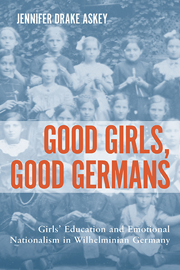Book contents
- Frontmatter
- Dedication
- Contents
- Acknowledgments
- Introduction: Emotional Nationalism and Germany’s Daughters
- 1 Nationalist Education and Prussia's höhere Töchter
- 2 Father's Library: German Classics in Girls' Schools and the Ownership of German Culture
- 3 Mädchenliteratur I—Backfischbücher and Historical Novels
- 4 Mädchenliteratur II—Queen Luise
- Conclusion
- Bibliography
- Index
3 - Mädchenliteratur I—Backfischbücher and Historical Novels
Published online by Cambridge University Press: 05 August 2013
- Frontmatter
- Dedication
- Contents
- Acknowledgments
- Introduction: Emotional Nationalism and Germany’s Daughters
- 1 Nationalist Education and Prussia's höhere Töchter
- 2 Father's Library: German Classics in Girls' Schools and the Ownership of German Culture
- 3 Mädchenliteratur I—Backfischbücher and Historical Novels
- 4 Mädchenliteratur II—Queen Luise
- Conclusion
- Bibliography
- Index
Summary
The Era of the Rise of the girls' school and the expansion of Prusso-German national feeling under King Wilhelm I of Hohenzollern (1861–1871; Emperor, 1871–1888) coincided with—and contributed to—a veritable explosion of the literary marketplace and its segmentation. This growth was especially visible in the children's and youth reading market, where schoolbook publishers took advantage of their strong market position and their trusted status with parents, clergy, and educators to expand their business beyond Lesebücher into popular fiction. And, indeed, book catalogs of the era classified youth literature not as belles lettres but as pedagogy, making the expansion of schoolbook publishers into the realm of fiction an obvious choice. Market growth and segmentation meant that books appeared on the market at a more rapid pace and were visibly targeted to either men or women, boys or girls, or perhaps to the middle-class family as a whole—and were designed to entice readers of varying ages and, corresponding to target market or genre, fit into a variety of budgets.
In this environment, the young female reader of 1880 enjoyed a far broader set of pleasure reading options than had her grandmother or even her mother. Nineteenth-century fiction for girls reflected its genesis in the moralische Wochenschriften of the eighteenth century and the almanacs, comportment guides, and advice books that sprung up alongside them.
- Type
- Chapter
- Information
- Good Girls, Good GermansGirls' Education and Emotional Nationalism in Wilhelminian Germany, pp. 103 - 142Publisher: Boydell & BrewerPrint publication year: 2013



